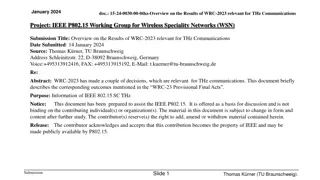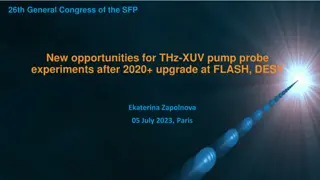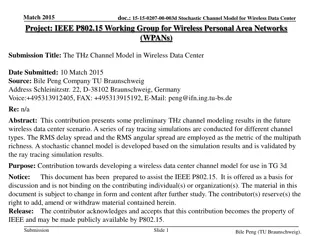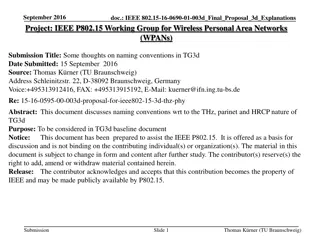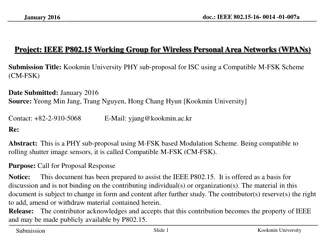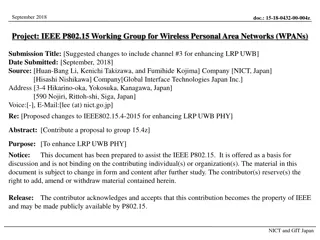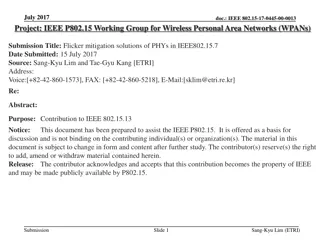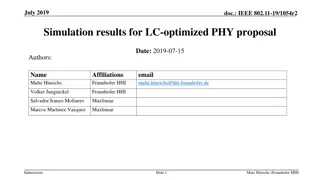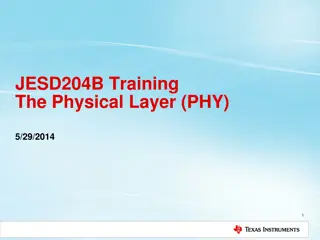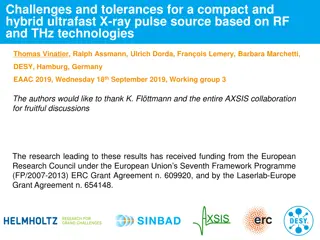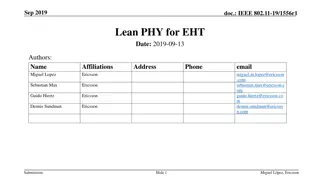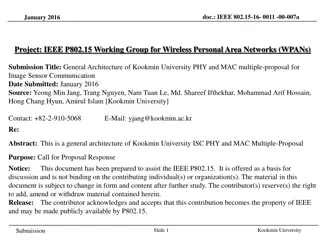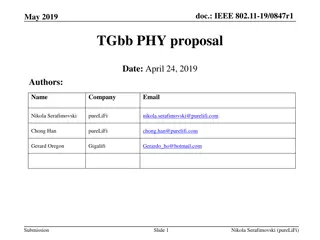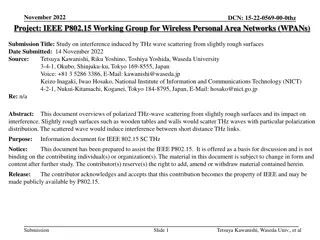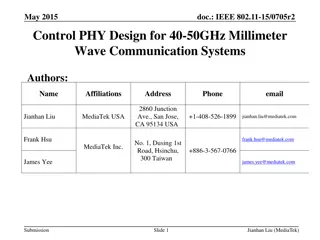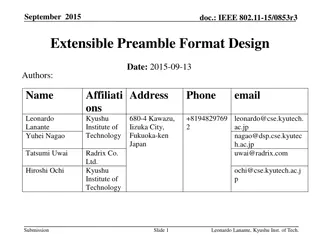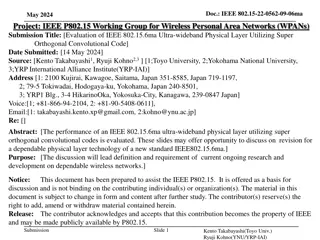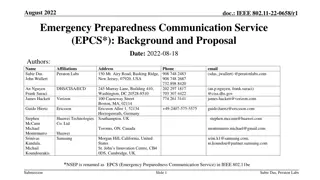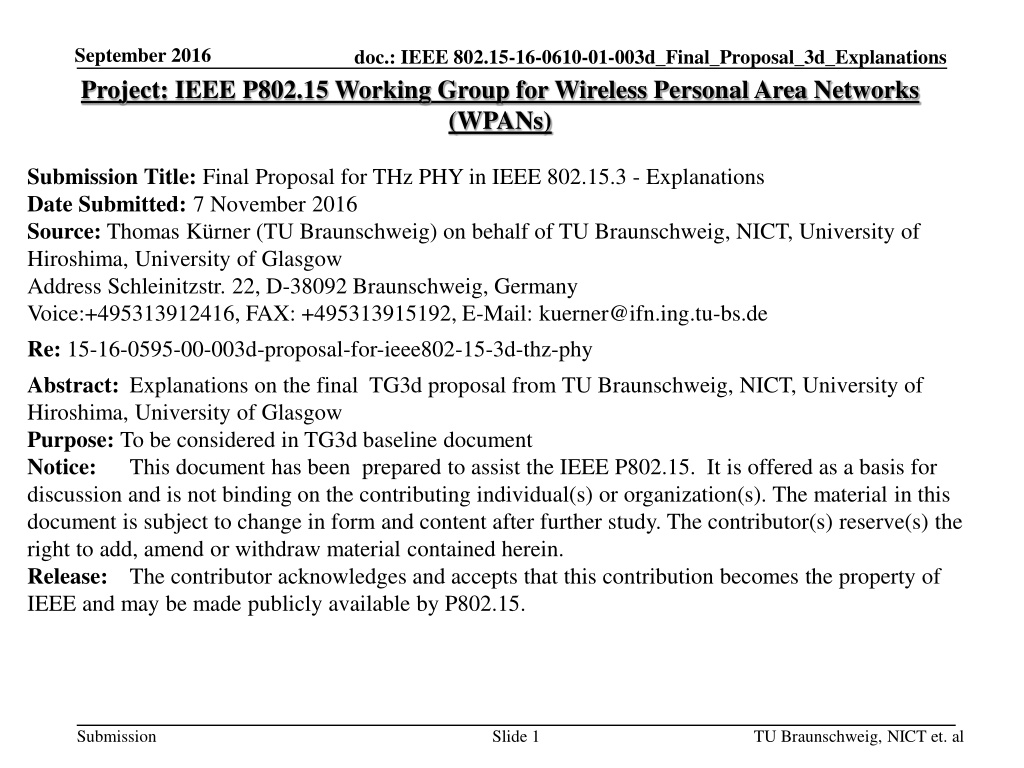
IEEE 802.15.3d Final Proposal for THz PHY Explanations
"Explore the final proposal for THz PHY in IEEE 802.15.3, providing explanations and insights from TU Braunschweig, NICT, University of Hiroshima, and University of Glasgow. Details include contributors, applications, modulation schemes, data rates, and more for consideration by the Wireless Personal Area Networks Working Group."
Download Presentation

Please find below an Image/Link to download the presentation.
The content on the website is provided AS IS for your information and personal use only. It may not be sold, licensed, or shared on other websites without obtaining consent from the author. Download presentation by click this link. If you encounter any issues during the download, it is possible that the publisher has removed the file from their server.
E N D
Presentation Transcript
September 2016 doc.: IEEE 802.15-16-0610-01-003d_Final_Proposal_3d_Explanations Project: IEEE P802.15 Working Group for Wireless Personal Area Networks (WPANs) Submission Title: Final Proposal for THz PHY in IEEE 802.15.3 - Explanations Date Submitted: 7 November 2016 Source: Thomas K rner (TU Braunschweig) on behalf of TU Braunschweig, NICT, University of Hiroshima, University of Glasgow Address Schleinitzstr. 22, D-38092 Braunschweig, Germany Voice:+495313912416, FAX: +495313915192, E-Mail: kuerner@ifn.ing.tu-bs.de Re: 15-16-0595-00-003d-proposal-for-ieee802-15-3d-thz-phy Abstract: Explanations on the final TG3d proposal from TU Braunschweig, NICT, University of Hiroshima, University of Glasgow Purpose: To be considered in TG3d baseline document Notice: This document has been prepared to assist the IEEE P802.15. It is offered as a basis for discussion and is not binding on the contributing individual(s) or organization(s). The material in this document is subject to change in form and content after further study. The contributor(s) reserve(s) the right to add, amend or withdraw material contained herein. Release: The contributor acknowledges and accepts that this contribution becomes the property of IEEE and may be made publicly available by P802.15. Submission Slide 1 TU Braunschweig, NICT et. al
September 2016 doc.: IEEE 802.15-16-0610-01-003d_Final_Proposal_3d_Explanations Final Proposal for a THz PHY in IEEE 802.15.3 - Explanations This document provides some further explanations to 15-16- 0595-00-003d-proposal-for-ieee802-15-3d-thz-phy The document is an evolution of the preliminary proposals presented in 15-16-0481-01-003d_preliminray_proposal_3d 15-16-0482-01-003d-preliminary-proposal-for-tg3d-cfp 15-16-0510-00-003d-Thoughts_towards_a_baseline_3d The explanations wrt RF channelization are presented in 15-16-0592-00-003d-proposal-for-ieee802-15-3d-channel- assignment-plans Submission Slide 2 TU Braunschweig, NICT et. al.
September 2016 doc.: IEEE 802.15-16-0610-01-003d_Final_Proposal_3d_Explanations List of Contributors Thomas K rner (TU Braunschweig) Iwao Hosako (NICT) Sebastian Rey (TU Braunschweig) Bile Peng (TU Braunschweig) Alexander Fricke (TU Braunschweig) Akifumi Kasamatsu (NICT) Norihiko Sekine (NICT) Hiroyo Ogawa (NICT) Minoru Fujishima (Hiroshima University) Anthony Kelly (University of Glasgow) This preliminary proposal is partially originating from the H2020-iBrow-project (www.ibrow-project.eu) Submission Slide 3 TU Braunschweig, NICT et. al.
September 2016 doc.: IEEE 802.15-16-0610-01-003d_Final_Proposal_3d_Explanations Outline Applications and Requirements for a 802.15.3d THz PHY Baseline for the final proposal Modulation Schemes Forward Error Correction Data Rates Link Budget Transmit PSD Mask Required Changes for the MAC Options to draft section on THz OOK PHY mode Criteria from TRD Issues for further studies Submission Slide 4 TU Braunschweig, NICT et. al.
September 2016 doc.: IEEE 802.15-16-0610-01-003d_Final_Proposal_3d_Explanations APPLICATIONS FOR A 802.15.3D THZ PHY Submission Slide 5 TU Braunschweig, NICT et. al.
September 2016 doc.: IEEE 802.15-16-0610-01-003d_Final_Proposal_3d_Explanations Applications for switched point-to-point links 10...100 Gbit/s 10...100 Gbit/s Kiosk downloads Intra-Device Communication 10...100 Gbit/s 10..100 Gbit/s Wireless Links in Data Centers Backhaul/Fronthaul links Submission Slide 6 TU Braunschweig, NICT et. al.
September 2016 doc.: IEEE 802.15-16-0610-01-003d_Final_Proposal_3d_Explanations Common Characteristics of all four Applications It can be assumed that a-priori knowledge of the locations of Tx and Rx is available. As a consequence the efforts for device discovery and beam tracking may be reduced. Only two DEVs are involved in communications. However links may be switched between different DEVs The point-to-point nature with the application of highly directive antennas may yield less complex channels and less complex interference situations Submission Slide 7 TU Braunschweig, NICT et. al.
September 2016 doc.: IEEE 802.15-16-0610-01-003d_Final_Proposal_3d_Explanations BASELINE FOR THE PRELIMINARY PROPOSAL Submission Slide 8 TU Braunschweig, NICT et. al.
September 2016 doc.: IEEE 802.15-16-0610-01-003d_Final_Proposal_3d_Explanations Frequency Range and RF Channelization This proposal defines a PHY for the frequency range 252 325 GHz (called the THz PHY) The links using the THz PHY are called THz links The THz PHY may use larger bandwidth as used in the millimeter wave PHY defined in IEEE 802.15.3RevA. This will allow the use of less complex modulation schemes. Submission Slide 9 TU Braunschweig, NICT et. al.
September 2016 doc.: IEEE 802.15-16-0610-01-003d_Final_Proposal_3d_Explanations Features defined in IEEE P802.15.3e (HRCP) The applications Kiosk Downloading and Intra-Device Communications have some similarities to the applications currently considered in IEEE P802.15.3e Some features developed in IEEE P802.15.3e may also be applied in conjunction with the THz PHY. The corresponding links will be called THz HRCP This proposal also inherits the concept of pairnet as defined in IEEE P802.15.3e. For non-HRCP THz links the beacon may be not switched off after establishing the connection. Submission Slide 10 TU Braunschweig, NICT et. al.
September 2016 doc.: IEEE 802.15-16-0610-01-003d_Final_Proposal_3d_Explanations Modulation and Coding Schemes In order to enable the reuse of implementations based on IEEE P802.15.3RevA and IEEE P802.15.3e the modulation and coding schemes defined in the corresponding standards should be adopted as much as possible. However, other more simple coding schemes are defined in this proposal as well. This will be possible due to the less complex situation wrt channel properties and interference and will reduce complexity Submission Slide 11 TU Braunschweig, NICT et. al.
September 2016 doc.: IEEE 802.15-16-0610-01-003d_Final_Proposal_3d_Explanations MODULATION SCHEMES Submission Slide 12 TU Braunschweig, NICT et. al.
September 2016 doc.: IEEE 802.15-16-0610-01-003d_Final_Proposal_3d_Explanations PHY Modes A compliant THz PHY shall implement at least one of the following PHY modes: a) Single carrier mode PHY /2-shift BPSK /2-shift QPSK /2-PSK /2-APSK 16-QAM 64-QAM A final decision, which modulation schemes are optional/required is for furthr discussion b) On-off keying mode PHY Clarification: OOK Phy and SC Phy are two alternatives. A device has to support only one of these. Submission Slide 13 TU Braunschweig, NICT et. al.
September 2016 doc.: IEEE 802.15-16-0610-01-003d_Final_Proposal_3d_Explanations Reasoning for Modulation Schemes of the SC mode PHY 1 /2-shift BPSK Compatible to existing standard /2-shift QPSK Reasonable data rate Compatible to existing standard 64 Gbit/s demonstrated e.g. in TERAPAN project (I. Kallfass et al, Towards MMIC-Based 300GHz Indoor Wireless Communication Systems, IEICE Trans. Electron, vol. E98.C, no. 12, pp. 1081 1090, 2015.) Submission Slide 14 TU Braunschweig, NICT et. al.
September 2016 doc.: IEEE 802.15-16-0610-01-003d_Final_Proposal_3d_Explanations Reasoning for Modulation Schemes of the SC mode PHY 2 /2-8-PSK Works for systems with limited linearity. 30 Gbit/s demonstrated in Millilink project at 240 GHz (J. Antes et al, Transmission of an 8-PSK modulated 30 Gbit/s signal using an MMIC-based 240 GHz wireless link. IEEE MTT-S International Microwave Symposium Digest (IMS), 2013.) /2-8-APSK Works for systems with limited linearity but in comparison is more robust to phase noise than 8-PSK. Submission Slide 15 TU Braunschweig, NICT et. al.
Septenber 2016 doc.: IEEE 802.15-16-0610-01-003d_Final_Proposal_3d_Explanations Reasoning for Modulation Schemes of the SC mode PHY 3 16 QAM 100 Gbit/s demonstrated at 240 GHz with an optical transmitter and an electronic receiver (S. Koenig et al, 100 Gbit/s Wireless Link with mm-Wave Photonics. Anaheim, California: Optical Society of America, 2013.) 64 QAM Example of QAM in 300 GHz band with Si-CMOS devices] - 32 QAM: 17.5 Gbit/s/ch (@ channel width = 5 GHz, 6 channels) ref. IEEE ISSCC2016, Digest pp. 342-343 If a higher order QAM (64 QAM) is supported than the 16 QAM (not 8-PSK or 8-APSK) has to be supported. Submission Slide 16 TU Braunschweig, NICT et. al.
September 2016 doc.: IEEE 802.15-16-0610-01-003d_Final_Proposal_3d_Explanations Reasoning for OOK Phy Enables an easier receiver architecture because no coherent modulation is used. All-electronic solutions at 300 GHz with OOK are currently developed within the iBROW project (www.ibrow-project.eu) based on Resonant Tunnelling Diode (RTD) technology Submission Slide 17 TU Braunschweig, NICT et. al.
September 2016 doc.: IEEE 802.15-16-0610-01-003d_Final_Proposal_3d_Explanations Reasoning for OOK Phy Simple modulation scheme trades spectral efficiency for simplicity and therefore cost RTD based devices with integrated antennas are being developed European groups and in particular the I- BROW project Systems demonstrated up to and beyond 300GHz Potentially very low cost technology in Japan, several Submission Slide 18 TU Braunschweig, NICT et. al.
September 2016 doc.: IEEE 802.15-16-0610-01-003d_Final_Proposal_3d_Explanations OOK based RTD communications Oscillators up to 1.92 THz have been demonstrated. [T. Maekawa, H. Kanaya, S. Suzuki, and M. Asada, Appl. Phys. Express, 9, 024101 (2016).] Wireless data transmission of 30 Gb/s at 490 GHz. [N. Oshima, H. Hashimoto, D. Horikawa, S. Suzuki, and M. Asada, IEEE International Microwave Symposium,San Francisco, THIF2, May 2016.] Receiver functionality has been demonstrated at 300GHz. communication at 300 GHz using resonant tunneling diode detector, in Proc. Asia-Pacific Microw. Conf. (APMC2011), pp. 1122-1125, Dec. 2011. ] [T. Shiode, T. Mukai, M. Kawamura, and T. Nagatsuma, Giga-bit wireless iBROW is developing systems for 10Gbit/s at 300GHz Submission Slide 19 TU Braunschweig, NICT et. al.
September 2016 doc.: IEEE 802.15-16-0610-01-003d_Final_Proposal_3d_Explanations FORWARD ERROR CORRECTION Submission Slide 20 TU Braunschweig, NICT et. al.
September 2016 doc.: IEEE 802.15-16-0610-01-003d_Final_Proposal_3d_Explanations A couple of FEC defined in IEEE P802.15.3- 2016 and IEEE P802.15.3e D04 The following FEC shall be reused: Rate 14/15 LDPC (1440,1344) Rate 11/15 LDPC (1440,1056) RS (255,239) in GF(28) In addition also more simple Haming-Code may be considered Current working assumption is that the LDPC codes are used for SC-PHY and RS-Codes are used for the OOK-PHY Submission Slide 21 TU Braunschweig, NICT et. al.
September 2016 doc.: IEEE 802.15-16-0610-01-003d_Final_Proposal_3d_Explanations Simpler FEC schemes Due to the extremely high data rate, a simpler FEC with less decoding complexity is of great advantage in hardware realization. The performance of a (7,4) Hamming code in an AWGN-channel is depicted in the figure on the right. See also: Doc. IEEE 802.15-13-0406-00 Submission Slide 22 TU Braunschweig, NICT et. al.
September 2016 doc.: IEEE 802.15-16-0610-01-003d_Final_Proposal_3d_Explanations Status of Evaluation Perfomance evaulations for the proposed modulation and coding schemes are currently being done using the channel models defined in the CMD. Some first results are presented in doc. 16/0746r1 Preliminary Performance of FEC Schemes in TG3d Channels Submission Slide 23 TU Braunschweig, NICT et. al.
September 2016 doc.: IEEE 802.15-16-0610-01-003d_Final_Proposal_3d_Explanations DATA RATES Submission Slide 24 TU Braunschweig, NICT et. al.
September 2016 doc.: IEEE 802.15-16-0610-01-003d_Final_Proposal_3d_Explanations Excerpt of Data Rates for SC-PHY at the higher end of the Bandwidth MCS identifier data rate (Gb/s) w/ PW 123,6480 32,3840 41,2160 64,7680 82,4320 97,1520 123,6480 97,1520 123,6480 129,5360 164,8640 194,3040 247,2960 data rate (Gb/s) w/o PW 108,1920 28,3360 36,0640 56,6720 72,1280 85,0080 108,1920 85,0080 108,1920 113,3440 144,2560 170,0160 216,3840 bandwidth (GHz) modulation FEC rate 71 72 73 74 75 76 77 78 79 80 81 82 83 25,92 51,84 51,84 51,84 51,84 51,84 51,84 51,84 51,84 51,84 51,84 51,84 51,84 64-QAM BPSK BPSK QPSK QPSK 8-PSK 8-PSK 8-APSK 8-APSK 16QAM 16-QAM 64-QAM 64-QAM 14/15 11/15 14/15 11/15 14/15 11/15 14/15 11/15 14/15 11/15 14/15 11/15 14/15 Submission Slide 25 TU Braunschweig, NICT et. al.
September 2016 doc.: IEEE 802.15-16-0610-01-003d_Final_Proposal_3d_Explanations Data Rates for OOK-PHY (complete table) MCS identifier bandwidth (GHz) Spreading Factor LSF 1 1 1 1 1 1 1 FEC rate data rate (Gb/s) w/ PW 1,64266667 3,28533333 6,57066667 9,856 13,1413333 19,712 39,424 data rate (Gb/s) w/o PW 1,43733333 2,87466667 5,74933333 8,624 11,4986667 17,248 34,496 0 1 2 3 4 5 6 2.16 4.32 8.64 12.96 17.28 25.92 51.84 224/240 224/240 224/240 224/240 224/240 224/240 224/240 Submission Slide 26 TU Braunschweig, NICT et. al.
September 2016 doc.: IEEE 802.15-16-0610-01-003d_Final_Proposal_3d_Explanations LINK BUDGET Submission Slide 27 TU Braunschweig, NICT et. al.
September 2016 doc.: IEEE 802.15-16-0610-01-003d_Final_Proposal_3d_Explanations Link Budget 1 Based on: I. Kallfass et al, Towards MMIC-Based 300GHz Indoor Wireless Communication Systems, IEICE Trans. Electron, vol. E98.C, no. 12, pp. 1081 1090, 2015. Tx Power: -4.0 dBm (Bandwidth 64 GHz) Rx noise figure 6.7 dB Thermal noise for a bandwidth of 51.840 GHz: -66.9 dBm Submission Slide 28 TU Braunschweig, NICT et. al.
September 2016 doc.: IEEE 802.15-16-0610-01-003d_Final_Proposal_3d_Explanations Link Budget 2 Assuming: Tx Power: -4.0 dBm Bandwidth 50.84 GHz Rx noise figure 6.7 dB For an SNR of 10 dB with only free space path loss: Distance [m] Required Gain per Antenna [dBi] 0.1 1 10 100 1,000 6.9 16.9 26.9 36.9 48.9 Covers the whole range of applications with different antennas. Submission Slide 29 TU Braunschweig, NICT et. al.
September 2016 doc.: IEEE 802.15-16-0610-01-003d_Final_Proposal_3d_Explanations TRANSMIT PSD MASK Submission Slide 30 TU Braunschweig, NICT et. al.
September 2016 doc.: IEEE 802.15-16-0610-01-003d_Final_Proposal_3d_Explanations Definition of a Generic PSD Mask For each of the seven defined bandwidths a separate PSD mask is required This proposal follows the concept in TG3e to define a generic mask with bandwidth-specific parameters Submission Slide 31 TU Braunschweig, NICT et. al.
September 2016 doc.: IEEE 802.15-16-0610-01-003d_Final_Proposal_3d_Explanations Definition of a Generic PSD Mask With the given chip rate, the attenuation is at -20 dB for f2= bandwidth/2 for a raised cosine filter. With this filter f1 is defined by ? =1+? factor ? For ? = 0.25 2?; with chip duration T and roll off PSD [dBr] f-fc[GHz] Submission Slide 32 TU Braunschweig, NICT et. al.
September 2016 doc.: IEEE 802.15-16-0610-01-003d_Final_Proposal_3d_Explanations Suggested Frequencies Channel Bandwidth [GHz] 2.160 4.320 8.640 12.960 17.280 25.920 51.840 69.120 ??[???] ??[???] 0.66 1.32 2.64 3.96 5.28 7.92 15.84 21.12 1.080 2.160 4.320 6.480 8.640 12.960 25.920 34.560 Submission Slide 33 TU Braunschweig, NICT et. al.
September 2016 doc.: IEEE 802.15-16-0610-01-003d_Final_Proposal_3d_Explanations REQUIRED CHANGES FOR THE MAC Submission Slide 34 TU Braunschweig, NICT et. al.
September 2016 doc.: IEEE 802.15-16-0610-01-003d_Final_Proposal_3d_Explanations Required Changes for the MAC The PAR allows changes of the MAC only to the extent, that the new PHY can be supported. The corresponding parts, that need to be changed are in chapter 6. Most of the details to be changed are for further studies On the following slide a proposal for the THz DEV capability field is made Submission Slide 35 TU Braunschweig, NICT et. al.
September 2016 doc.: IEEE 802.15-16-0610-01-003d_Final_Proposal_3d_Explanations DEV Capability Field (equivalent to figure 6-88b in draft 802.15.3e-D04 Bits b0-b23 are identical to the draft of 802.15.3e-D04 Bits b24-b29 Capability SC supported MCS meaning b24: SC /2-shift BPSK supported b25: SC /2-shift QPSK supported b26: SC /2-shift 8-PSK supported b27: SC /2-shift 8-APSK supported b28: SC 16-QAM supported b29: SC 64-QAM supported b30: OOK spreading used b30 b31 b31-b37 OOK spreading Reserved Channel bandwidth supported b31: 2.16 GHz b32: 4.32 GHz b33: 8.64 GHz b34: 12.96 GHz b35: 17.28 GHz b36: 25.92 GHz b37: 51.84 GHz b38 b39-b70 Reserved Spectrum part supported Spectrum parts given in the smallest granularity of 2.16 GHz; spectrum range corresponds to the spectrum ranges defined by the spectrum ranges of CHNL_ID 1 to 32) b(38+ CHNL_ID) Note: in the final draft the spectrum may be given in absolute numbers here B71 Reserved Submission Slide 36 TU Braunschweig, NICT et. al.
September 2016 doc.: IEEE 802.15-16-0610-01-003d_Final_Proposal_3d_Explanations Example for configuration of the Spectrum part supported in the DEV Capability Field BW(GHz) Ch 25 Ch 26 Ch 27 Ch 28 Ch 29 Ch 30 Ch 31 Ch 32 Ch 1 Ch 2 Ch 3 Ch 4 Ch 5 Ch 6 Ch 7 Ch 8 Ch 9 Ch 10 Ch 11 Ch 12 Ch 13 Ch 14 Ch 15 Ch 16 Ch 17 Ch 18 Ch 19 Ch 20 Ch 21 Ch 22 Ch 23 Ch 24 f GHz 2.16 Ch 33 Ch 34 Ch 35 Ch 36 Ch 37 Ch 38 Ch 39 Ch 40 Ch 41 Ch 42 Ch 43 Ch 44 Ch 45 Ch 46 Ch 47 Ch 48 f GHz 4.32 Ch 49 Ch 50 Ch 51 Ch 52 Ch 53 Ch 54 Ch 55 Ch 56 f GHz 8.64 f GHz Ch 61 Ch 57 Ch 58 Ch 59 Ch 60 12.96 Ch 65 Ch 62 Ch 63 Ch 64 17.28 f GHz Ch 66 Ch 67 25.92 f GHz Ch 68 51.84 f GHz 250 255 260 265 270 275 280 285 290 295 300 305 310 315 320 304.56 321.84 252.72 Submission Slide 37 TU Braunschweig, NICT et. al.
September 2016 doc.: IEEE 802.15-16-0610-01-003d_Final_Proposal_3d_Explanations OPTIONS TO DRAFT SECTION ON THZ OOK PHY MODE Submission Slide 38 TU Braunschweig, NICT et. al.
September 2016 doc.: IEEE 802.15-16-0610-01-003d_Final_Proposal_3d_Explanations Current Status of Clause 11b.3 The OOK-PHY is described in clause 11b.3 of the proposal Currently the proposal includes only proposals on the modulation and coding scheme The remaining part of clause 11b.3 is for further discussion. Two options are proposed: option1: to follow the structure of 11a.3 (HRCP-OOK) option 2: to follow largely the structure of 11b.2 (THz-SC PHY) Submission Slide 39 TU Braunschweig, NICT et. al.
September 2016 doc.: IEEE 802.15-16-0610-01-003d_Final_Proposal_3d_Explanations FULLFILLMENT OF CRITERIA FROM TRD Submission Slide 40 TU Braunschweig, NICT et. al.
September 2016 doc.: IEEE 802.15-16-0610-01-003d_Final_Proposal_3d_Explanations TRD Criteria Section in TRD Grade of Fullfillment 8. Data rates Data rates fulfilled (Table 11b-1); BER need to be checked by simulations Fullfilled ,see slide 31 9. Transmission range 10. Operational Freqeuncy Bands Fulfilled, see Table 11b-1 11. Regulatory Requirements To be provided once all transmitter characteristiscs are fixed Existing Mechanism from 802.15.3-2016 and P802.15.3e will be inherited Existing Mechanism from 802.15.3-2016 and P802.15.3e will be inherited To be provided based on ongoing research projects 12. Media Access Mechanism 16. Security Mechanism 17. Size and Power Submission Slide 41 TU Braunschweig, NICT et. al.
September 2016 doc.: IEEE 802.15-16-0610-01-003d_Final_Proposal_3d_Explanations ISSUES FOR FURTHER STUDIES Submission Slide 42 TU Braunschweig, NICT et. al.
September 2016 doc.: IEEE 802.15-16-0610-01-003d_Final_Proposal_3d_Explanations List of open Issues for further studies The following essential issues need to be resolved before the draft standard can be completed: PSD Mask: Definition of parameters in Table 11b-3 FEC: Simulations using models from CMD and based on the achieved results selection of final schemes Transmitter and receiver characteristics: EVM requirements and reference sensitivity levels have to be defined MAC: All required changes to the MAC have to be identified (chapter 6) OOK: Decision on the structure of clause on OOK-mode Submission Slide 43 TU Braunschweig, NICT et. al.

